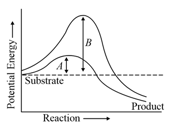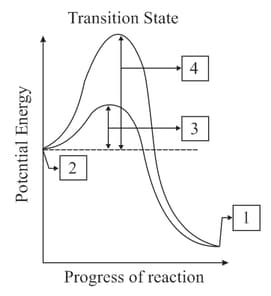HARD
Earn 100
Read the following statements:
A. Living state and metabolism are synonymous.
B. All enzymes are proteins without any exception.
C. Zn acts as a cofactor for the enzyme carbonic anhydrase.
D. At high temperatures inorganic catalysts work efficiently while the enzymes are damaged.
Correct statements are:
A. Living state and metabolism are synonymous.
B. All enzymes are proteins without any exception.
C. Zn acts as a cofactor for the enzyme carbonic anhydrase.
D. At high temperatures inorganic catalysts work efficiently while the enzymes are damaged.
(a)Two
(b)One
(c)Four
(d)Three
50% studentsanswered this correctly
Important Questions on Develop and use a model to illustrate the hierarchical organization of interacting systems that provide specific functions within multicellular organisms.
HARD
Life Sciences>From Molecules to Organisms: Structures and Processes>Develop and use a model to illustrate the hierarchical organization of interacting systems that provide specific functions within multicellular organisms.>Structure and Function - Multicellular organisms have a hierarchical structural organization, in which any one system is made up of numerous parts and is itself a component of the next level
MEDIUM
Life Sciences>From Molecules to Organisms: Structures and Processes>Develop and use a model to illustrate the hierarchical organization of interacting systems that provide specific functions within multicellular organisms.>Structure and Function - Multicellular organisms have a hierarchical structural organization, in which any one system is made up of numerous parts and is itself a component of the next level
HARD
Life Sciences>From Molecules to Organisms: Structures and Processes>Develop and use a model to illustrate the hierarchical organization of interacting systems that provide specific functions within multicellular organisms.>Structure and Function - Multicellular organisms have a hierarchical structural organization, in which any one system is made up of numerous parts and is itself a component of the next level
EASY
Life Sciences>From Molecules to Organisms: Structures and Processes>Develop and use a model to illustrate the hierarchical organization of interacting systems that provide specific functions within multicellular organisms.>Structure and Function - Multicellular organisms have a hierarchical structural organization, in which any one system is made up of numerous parts and is itself a component of the next level
MEDIUM
Life Sciences>From Molecules to Organisms: Structures and Processes>Develop and use a model to illustrate the hierarchical organization of interacting systems that provide specific functions within multicellular organisms.>Structure and Function - Multicellular organisms have a hierarchical structural organization, in which any one system is made up of numerous parts and is itself a component of the next level
A) Catalytic RNA
B) Non-Protein enzymes
C) Nucleic acids
D) Group of ribosomes
HARD
Life Sciences>From Molecules to Organisms: Structures and Processes>Develop and use a model to illustrate the hierarchical organization of interacting systems that provide specific functions within multicellular organisms.>Structure and Function - Multicellular organisms have a hierarchical structural organization, in which any one system is made up of numerous parts and is itself a component of the next level
EASY
Life Sciences>From Molecules to Organisms: Structures and Processes>Develop and use a model to illustrate the hierarchical organization of interacting systems that provide specific functions within multicellular organisms.>Structure and Function - Multicellular organisms have a hierarchical structural organization, in which any one system is made up of numerous parts and is itself a component of the next level
HARD
Life Sciences>From Molecules to Organisms: Structures and Processes>Develop and use a model to illustrate the hierarchical organization of interacting systems that provide specific functions within multicellular organisms.>Structure and Function - Multicellular organisms have a hierarchical structural organization, in which any one system is made up of numerous parts and is itself a component of the next level


MEDIUM
Life Sciences>From Molecules to Organisms: Structures and Processes>Develop and use a model to illustrate the hierarchical organization of interacting systems that provide specific functions within multicellular organisms.>Structure and Function - Multicellular organisms have a hierarchical structural organization, in which any one system is made up of numerous parts and is itself a component of the next level

EASY
Life Sciences>From Molecules to Organisms: Structures and Processes>Develop and use a model to illustrate the hierarchical organization of interacting systems that provide specific functions within multicellular organisms.>Structure and Function - Multicellular organisms have a hierarchical structural organization, in which any one system is made up of numerous parts and is itself a component of the next level
Identify the labelled parts in the concept of activation energy shown in the below diagram?

EASY
Life Sciences>From Molecules to Organisms: Structures and Processes>Develop and use a model to illustrate the hierarchical organization of interacting systems that provide specific functions within multicellular organisms.>Structure and Function - Multicellular organisms have a hierarchical structural organization, in which any one system is made up of numerous parts and is itself a component of the next level
HARD
Life Sciences>From Molecules to Organisms: Structures and Processes>Develop and use a model to illustrate the hierarchical organization of interacting systems that provide specific functions within multicellular organisms.>Structure and Function - Multicellular organisms have a hierarchical structural organization, in which any one system is made up of numerous parts and is itself a component of the next level
Study the following
| (I) | value | Affinity of the enzyme | Inverse measure enzyme affinity |
| (II) | Hydrolases | bonds | Linking compounds |
| (III) | Transferases | Transfer of a group | Inhibitor of reaction |
| (IV) | Emil Fisher | Lock and key hypothesis | Formation of ES complex |
The correct combinations are
MEDIUM
Life Sciences>From Molecules to Organisms: Structures and Processes>Develop and use a model to illustrate the hierarchical organization of interacting systems that provide specific functions within multicellular organisms.>Structure and Function - Multicellular organisms have a hierarchical structural organization, in which any one system is made up of numerous parts and is itself a component of the next level
HARD
Life Sciences>From Molecules to Organisms: Structures and Processes>Develop and use a model to illustrate the hierarchical organization of interacting systems that provide specific functions within multicellular organisms.>Structure and Function - Multicellular organisms have a hierarchical structural organization, in which any one system is made up of numerous parts and is itself a component of the next level
EASY
Life Sciences>From Molecules to Organisms: Structures and Processes>Develop and use a model to illustrate the hierarchical organization of interacting systems that provide specific functions within multicellular organisms.>Structure and Function - Multicellular organisms have a hierarchical structural organization, in which any one system is made up of numerous parts and is itself a component of the next level
EASY
Life Sciences>From Molecules to Organisms: Structures and Processes>Develop and use a model to illustrate the hierarchical organization of interacting systems that provide specific functions within multicellular organisms.>Structure and Function - Multicellular organisms have a hierarchical structural organization, in which any one system is made up of numerous parts and is itself a component of the next level
MEDIUM
Life Sciences>From Molecules to Organisms: Structures and Processes>Develop and use a model to illustrate the hierarchical organization of interacting systems that provide specific functions within multicellular organisms.>Structure and Function - Multicellular organisms have a hierarchical structural organization, in which any one system is made up of numerous parts and is itself a component of the next level
EASY
Life Sciences>From Molecules to Organisms: Structures and Processes>Develop and use a model to illustrate the hierarchical organization of interacting systems that provide specific functions within multicellular organisms.>Structure and Function - Multicellular organisms have a hierarchical structural organization, in which any one system is made up of numerous parts and is itself a component of the next level
Match the following?
| Enzymes | Functions | ||
| (a) | Lyases | (i) | Oxido reduction |
| (b) | Isomerases | (ii) | Link compounds |
| (c) | Dehydrogenases | (iii) | Transfer of group |
| (d) | Ligases | (iv) | Interconversion |
| (v) | Removal of groups | ||
EASY
Life Sciences>From Molecules to Organisms: Structures and Processes>Develop and use a model to illustrate the hierarchical organization of interacting systems that provide specific functions within multicellular organisms.>Structure and Function - Multicellular organisms have a hierarchical structural organization, in which any one system is made up of numerous parts and is itself a component of the next level
MEDIUM
Life Sciences>From Molecules to Organisms: Structures and Processes>Develop and use a model to illustrate the hierarchical organization of interacting systems that provide specific functions within multicellular organisms.>Structure and Function - Multicellular organisms have a hierarchical structural organization, in which any one system is made up of numerous parts and is itself a component of the next level

